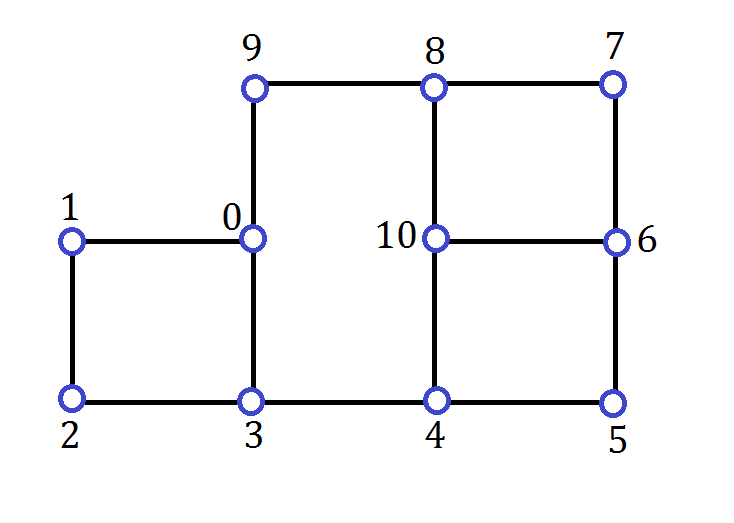(a) [1 mark] How small can a minimum dominating set be for a connected graph on n vertices?
Give an example of a graph on 8 vertices that realizes your bound.
(b) [1 mark] How big can a minimum dominating set be for a graph on n vertices?
Give an example of a graph on 8 vertices that realizes your bound.
(c) [3 marks] How big can a minimum dominating set be for a connected graph on n vertices?
Give an example of a graph on 8 vertices that realizes your bound.
Given a connected n-vertex graph G, your answer to (a) is giving a lower bound on the size of its minimum dominating set and (c) gives an upper bound.

(a) [1 mark] What is the degree sequence of G?
(b) [1 mark] List the degrees in order from smallest to largest.
(c) [2 marks] Give a tight lower bound B on the size of a minimum dominating set for a graph with this degree sequence.
(d) [2 marks] Draw a graph with the same multi-set of degrees as G that has a dominating set of size B (from part (c)).
(e) [2 marks] Give a minimum dominating set for G.
(f) [7 marks] Prove that G has no dominating sets of size B (from part (c)).
Hint: you probably have to do a case by case analysis for your
proof. For example, maybe start by considering two cases:
Case 1: Vertex 0 is in the dominating set.
Case 2: Vertex 0 is not in the dominating set.
The cases can have subcases that you should number systematically,
for example Cases 1.1 and 1.2.
(a) [5 marks] Find a minimum dominating set for the k-prism for k=3, 4, 5, 6 and show your answers on the attached Prism Worksheet
(b) [5 marks] Give a formula for the minimum dominating set order of a k-prism in terms of the number of vertices that it has. Hint: your formula should consider four cases: n/2 is congruent to 0, 1, 2, or 3 modulo 4.
[Definition: For integers, n, r, and k, n is conguent to r modulo k if n= ck + r for some integer c.]
(c) [10 marks] For each case from (b), argue that it is not possible to find a smaller dominating set.
For questions #4 and #5, the algorithms presented operate by assigning colors to the vertices of a graph. Initially all vertices are white (undecided). Red vertices are in the dominating set, and blue ones are excluded. The dominating set D returned by the algorithm is the set of red vertices.
Given a graph G and a minimum dominating set D, does there always exist some permutation p so that Algorithm #1 returns D? If you answer "yes", then explain how to compute such a permutation p from the dominating set D. If your answer is "no", give a counterexample consisting of a graph G and a minimum dominating set D, and show that there is no permutation of the vertices for which the algorithm returns D.
Given a graph G and a minimum dominating set D, does there always exist some BFS-ordering p so that Algorithm #1 returns D? If you answer "yes", then explain how to compute such a BFS-ordering p from the dominating set D. If your answer is "no", give a counterexample consisting of a graph G and a minimum dominating set D, and show that there is no BFS-ordering of the vertices for which the algorithm returns D.